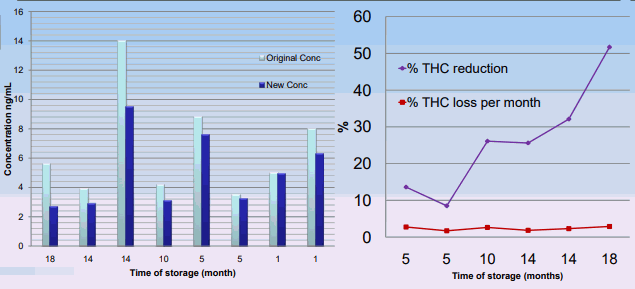Abstract
- Using proficiency samples of known concentration received between January 2008 and May 2009, the stability of THC in oral fluid was determined.
- Data was collected by GC/MS and the results were compared to originally reported values.
Objectives
- To determine stability of THC in neat oral fluid proficiency samples.
Methods
- Neat oral fluid proficiency samples (3mL, pH 7.0) were received from RTI International, NC.
- The immunoassay screening and GC/MS quantitation were carried out initially upon receipt of the specimens.
- TSamples were re-analyzed in June 2009.
- All samples (N=8) and calibrators were diluted 1+3 with Quantisal™ buffer prior to analysis, however samples were not stored in Quantisal™ buffer.
Results
- Of the 25 proficiency samples 8 tested positive for THC. Originally reported results were all within +/- 20% of expected concentrations, based on target values provided by RTI.
- Samples that were reanalyzed were stored for various lengths of time 18, 14, 10, 5 and 1 month increments. All samples showed some amount of drug loss..
- After 18 months the percentage loss of THC was 51% and after 1 month, only a 2% loss was observed. With the exception of one outlier the percentage loss per month when calculated for each sample was very consistent, with a range from 1.7% to 2.8%.
- The one outlier had an original concentration of 8ng/mL and after 1 month of storage the concentration had fallen to 6.3ng/mL (21% loss). However, on average a loss of 2.2% was observed per month of storage.
Total loss of THC and Percentage loss of THC per month

Data Summary

Summary
- THC in neat oral fluid appears to degrade at a consistent rate of approximately 2.2% per month when stored in glass bottles at 4 C.
- In comparison, data collected in 2008 from oral fluid samples stored in the Quantisal™ buffer showed an average loss of 1.6% per month over 9 months (reported at SOFT 2008).
- After 18 months the percentage loss of THC was 51% and after 1 month, only a 2% loss was observed. With the exception of one outlier the percentage loss per month when calculated for each sample was very consistent, with a range from 1.7% to 2.8%.
- The one outlier had an original concentration of 8ng/mL and after 1 month of storage the concentration had fallen to 6.3ng/mL (21% loss). However, on average a loss of 2.2% was observed per month of storage.
SOFT, Oklahoma City, 2009
To view the full data, click here.
Check out these reagent products from Immunalysis on Block Scientific


